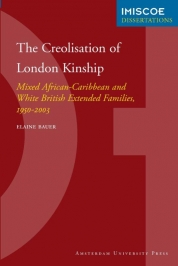The Creolisation of London Kinship: Mixed African-Caribbean and White British Extended Families, 1950-2003Posted in Anthropology, Books, History, Media Archive, Monographs, Social Science, United Kingdom on 2011-03-18 04:44Z by Steven |
Amsterdam University Press
November 2010
282 pages
paperback ISBN: 978 90 8964 235 6
Elaine Bauer, Fellow at the Young Foundation; Associate Fellow at the Institute for the Study of the Americas, University of London
In the last 50 years, the United Kingdom has witnessed a growing proportion of mixed African-Caribbean and white British families. With rich new primary evidence of mixed-race in the capital city, The Creolisation of London Kinship thoughtfully explores this population. Making an indelible contribution to both kinship research and wider social debates, the book emphasises a long-term evolution of family relationships across generations. Individuals are followed through changing social and historical contexts, seeking to understand in how far many of these transformations may be interpreted as creolisation. Examined, too, are strategies and innovations in relationship construction, the social constraints put upon them, the special significance of women and children in kinship work and the importance of non-biological as well as biological notions of family relatedness.



